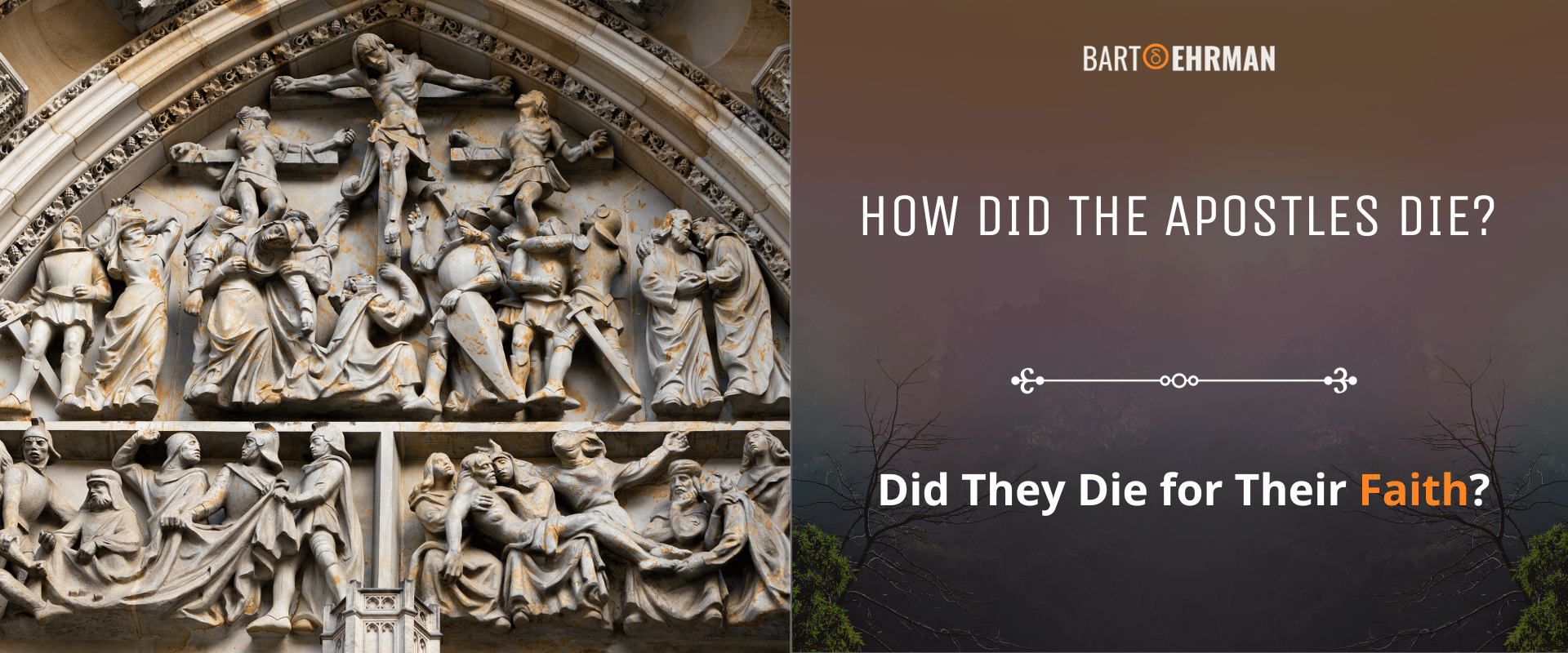How Did the Apostles Die? Did They Die for Their Faith?

Written by Joshua Schachterle, Ph.D
Author | Professor | Scholar
Author | Professor | BE Contributor
Verified! See our editorial guidelines
Verified! See our guidelines
Date written: November 28th, 2023
Disclaimer: The views and opinions expressed in this article belong to the author and do not necessarily match my own. - Dr. Bart D. Ehrman
Do historians know for certain how the apostles died? Did they die a "martyr's" death? There are certainly many traditions about their deaths, almost all of them involving violent deaths for their faith. Does the Bible tell us anything about their deaths? In this article I’ll explore these questions from a historical point of view.

What Is a Martyr?
The Greek word "martys" from which English derives the word martyr originally meant “witness.” It was a legal term for witnesses to a crime, for example. However, in the first centuries of Christianity, the word developed an additional layer of meaning – those died for their faith. This was because martyrs were said to be witnesses in the sense telling people what they had experienced through Christ. During periods of persecution, they were sometimes put to death for this.
While Christians really were executed for their faith, scholar Candida Moss notes that "on the Roman side, there is very little historical or archeological evidence for the widespread persecution of Christians.” In other words, persecution did happen, but it happened much less than it would seem from the many stories of martyrs written by early Christians.
In addition, Moss writes that all stories of martyrdom have been “purposely recast by later generations of Christians in order to further their own theological agendas." This means, unfortunately, that it is difficult to separate myth from history in stories of martyrdom.
So, in the rest of this article, I’ll explore stories about the deaths of the apostles while cautioning readers that scholars can’t know with any certainty how true the details are.
The Deaths of the Apostles
It may surprise you to know that only one story of the martyrdom of an apostle is narrated in the Bible, that of James, son of Zebedee. This means that all the other stories of apostles’ deaths come from later decades and centuries and are therefore less historically reliable. With that said, I’ll start with stories of the deaths of Jesus’ original disciples and end with Paul.
The Death of the Apostle Peter
Peter was one of the leaders of the apostles. Since his death is not written about in the New Testament, we’ll have to look to other sources.
One of our earliest sources about Peter outside the New Testament is 1 Clement, an anonymous letter from a member of the Church in Rome to the Church at Corinth. Most scholars date it to the 90s CE while they place Peter’s death between 64-68 CE.
In this letter, the end of Peter’s life is remembered very succinctly:
Peter, through unrighteous envy, endured not one or two, but numerous labors, and when he had finally suffered martyrdom, departed to the place of glory due to him.
While we are told that he died a martyr, the letter doesn’t say exactly where or how Peter died. The author may have assumed that everyone in the Church already knew these details.
Another source that refers to Peter’s death is the Acts of Peter, a 2nd-century narrative text in which Peter goes to Rome as a missionary. Since Church tradition says that Peter died in Rome, this is significant.
According to this text, Peter is arrested and condemned to be crucified. At this point, he makes an odd request: he asks to be crucified upside down. The Romans are happy to oblige.
Why does he ask for this? In the Acts of Peter, he makes a short speech explaining that it is a symbolic gesture. He says that humans had been corrupted by sin, symbolized by Peter’s inversion on the cross. Christ, however, had come to put the world right, symbolized by his crucifixion right side up.
However, Jerome, a later Christian author writing in the 4th century, knows about Peter’s inverted crucifixion, but has a different explanation. He says that Peter requested this because he thought himself unworthy to be executed in the same manner as Jesus.
The Death of the Apostle Andrew
Andrew was Peter’s brother and one of the first disciples called by Jesus.
In a 2nd or 3rd century text called the Acts of Andrew, it says that Andrew was crucified in a Greek city called Patras in the year 60 CE. It also says that Andrew tied, not nailed, to his cross.
However, there is another tradition that says he was crucified on an X-shaped cross which he requested because he didn’t think he was worthy of dying the same way Jesus had. That story is so similar to Peter’s story, however, that its historicity is questionable.
The Death of the Apostle James, Son of Zebedee
This James (there are several in the New Testament) was one of Jesus’ inner circle along with his brother John and Peter.
James is the only apostle whose martyrdom is recorded in the New Testament (Acts 12:1-2).
About that time King Herod laid violent hands upon some who belonged to the church. He had James, the brother of John, killed with the sword.
The Herod in these verses is probably Herod Agrippa, the grandson of Herod the Great. There is no record outside the New Testament of Herod persecuting Christians. It is therefore possible but unlikely.
The Death of the Apostle John, son of Zebedee
John was James’ brother, one of the three apostles who formed Jesus’ inner circle. Some traditions say he was “the disciple whom Jesus loved” from the Gospel of John, although there is no historical evidence for this belief.
However, this belief about John prompted some Christians to believe that John had outlived all the other apostles, eventually dying of old age in the city of Ephesus. If this is true, he was the only apostle not to die as a martyr.
But there is another story of John's death which may have come from a 2nd-century bishop named Papias, that John was “killed by the Jews.” Most scholars doubt this version as much as they doubt that John was the beloved disciple.
The Death of the Apostle Philip
Unlike Peter, James, and John, Philip, while he is named as a disciple in the Gospels, is not well-known and therefore has fewer stories written about him.
There is a later Christians text called the Acts of Philip, written sometime in the 4th century. In this story, Philip, his sister Mariamne, and Bartholomew traveled to Greece and Syria as missionaries. At the end of this text, Philip converts the wife of the leader of a city. The leader doesn’t like this and has Philip and Bartholomew crucified upside-down, probably another reference to Peter’s martyrdom.
In another tradition, Philip is martyred by decapitation in the city of Hierapolis. Neither of these options carry much historical weight since there is no other evidence to back them up.
The Death of the Apostle Bartholomew (also called Nathanael)
Tradition says that Bartholomew, along with Thaddeus/Jude brought Christianity to Armenia in the 1st century. They are still deemed the patron saints of the Armenian Church.
There are three traditional descriptions of Bartholomew's death. In the first, he is beaten unconscious and drowned in the ocean. In the second, he is crucified upside down. In the third, he is decapitated after being flayed alive. The implication is that his death was the result of violent persecution for his faith. While all of these are possible, none has any historical evidence to back them up.
The Death of the Apostle Thomas
You may recognize Thomas from the Doubting Thomas story in the Gospel of John in which Thomas doesn’t believe in Jesus’ resurrection until he is able to touch the risen Jesus. Tradition says he brought Christianity to India.
One later source for the death of Thomas is the Acts of Thomas, written in the 2nd or 3rd centuries. As usual, though, the huge time gap between the life of Thomas and the composition of the text diminishes its historical value considerably.
In this text, a king named Misdeus becomes angry when Thomas converts the queen, as well as the king's son, his sister-in-law and her friend. Misdeus orders soldiers to take Thomas outside the city where they stab him to death with spears.
The Death of the Apostle Matthew/Levi
Mark mentions Matthew as a disciple but doesn’t refer to his background. In the Gospel of Matthew, Matthew is a tax collector and since Mark and Luke include Jesus calling a tax collector named Levi to be a disciple, tradition has said that they are one and the same.
Second-century Christian authors Irenaeus and Clement of Alexandria both say that Matthew first preached to Jews in Judea, before going to other countries as a missionary. One of those countries was apparently Ethiopia.
According to tradition, in Ethiopia Matthew converted the daughter of King Egippus, in effect making her a nun. When another king succeeded Egippus, he asked Matthew to convince the daughter to be his wife. Matthew invited the king to church where he publicly scolded him for wanting the woman. The angry king immediately told one of his guards to kill Matthew on the spot
Note that this trope – apostle converts wife or other family member of ruler, ruler gets angry and kills apostle – is abundantly common in these stories, making their historicity dubious at best.
The Death of the Apostle James, son of Alphaeus
This James is also called James the Less, probably because he was younger than the other disciple named James. There is very little information about the death of James the Less, although one tradition has him being crucified in Egypt where he is preaching the gospel.
The Death of the Apostle Thaddeus/Judas
In Matthew and Mark this disciple is called Thaddeus while in Luke and John he is called Judas (or at least church tradition identifies them as the same person).
According to tradition, Thaddeus was killed in Beirut, Lebanon in 65 CE along with Simon the Zealot (see below), who is often said to be his preaching partner. He is often shown in Christian art holding an axe which symbolizes that he was decapitated. This comes from a text called the Acts of Simon and Jude.

The Death of the Apostle Simon the Cananaean (also called Simon the Zealot)
The first name details Simon’s place of origin while the second says that he was a member of a radical Jewish political group called the Zealots. As I mentioned above, he is often associated with Thaddeus/Jude the Apostle as a missionary duo. Like Thaddeus/Jude, tradition says Simon was martyred in 65 AD.
The Death of the Apostle Judas Iscariot
While there isn’t a lot of historical evidence, most scholars think Judas Iscariot was a real person.
The first (possible) written reference to Judas comes from 1 Corinthians 11:23–24. In this letter about Jesus’ last days, Paul writes that Jesus was “handed over,” which could be an allusion to Judas’ betrayal although Paul never mentions Judas by name.
Judas wasn’t martyred for his faith. There are several different accounts of his death, starting with the New Testament. Matthew says that Judas hanged himself out of shame for his betrayal of Jesus. The book of Acts 1:18 says that Judas used the 30 pieces of silver he got for betraying Jesus to buy a field in which "falling headlong, he burst open in the middle, and all his bowels gushed out." It’s not clear from this account whether his death was suicide or merely a horrible accident.
Papias, whom I mentioned earlier, wrote in the 2nd century that Judas was punished by God for his betrayal. How? He says that his body became hugely bloated so that he couldn’t even walk down a street between buildings. After enduring this punishment for a while, he killed himself on his own land by somehow pouring his intestines out. This apparently smelled so bad that a century later it still stank.
While the story of Judas committing suicide may be plausible, I’m pretty sure most historians wouldn’t take Papias’ story at face value.
The Death of the Apostle Paul
While Paul was not a disciple – he never met Jesus while he was alive – he clearly thought of himself as an apostle, one sent as a messenger to the gentiles on behalf of the resurrected Jesus. His letters in the New Testament were enormously influential on the development of Christianity. So how did Paul die?
According to Acts, Paul was arrested in Jerusalem, perhaps for instigating some kind of unrest. Although we can’t be sure of all the details as presented in Acts, he appears to have been transported to Rome by Roman soldiers and put under house arrest. Since we know from his letters that Paul was put in jail several times, this is plausible.
The bad news? Paul was in Rome at the time of Nero’s persecution of Christians. This started in 64 CE right after the Great Fire of Rome. Consequently, Paul was probably killed as part of that general persecution between 64-68 CE.
Since Paul was a Roman citizen, not from Palestine like the disciples, he would not have been executed by crucifixion as Peter probably was. Instead, he was likely beheaded since that was the preferred method of capital punishment for Roman citizens.
Conclusion: How Did the Apostles Die?
How much can we really know about their deaths? The martyrdom stories of the apostles are steeped in myth, as you can see by the similarity of many of the stories. While the stories of Peter and Paul are easier to decipher, the rest are quite uncertain.
Did the apostles die for their faith? Again, it’s difficult to separate myth and fact in these stories. While it’s always possible that they died as a result of their preaching, there’s very little historical or archeological evidence to either confirm or deny this.

